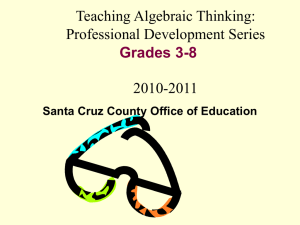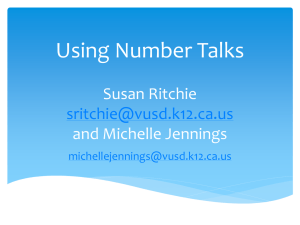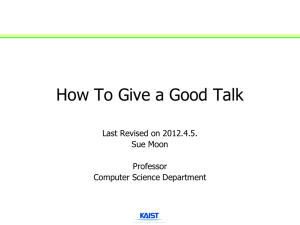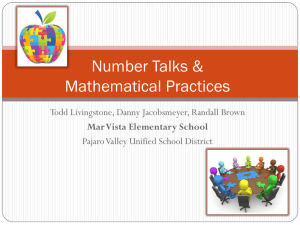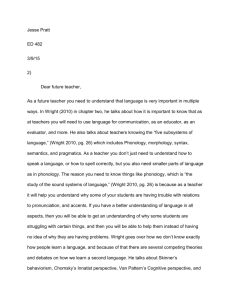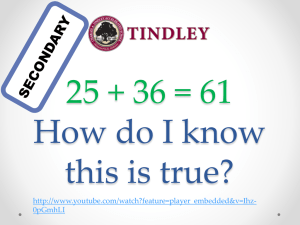JessicaSuter
advertisement
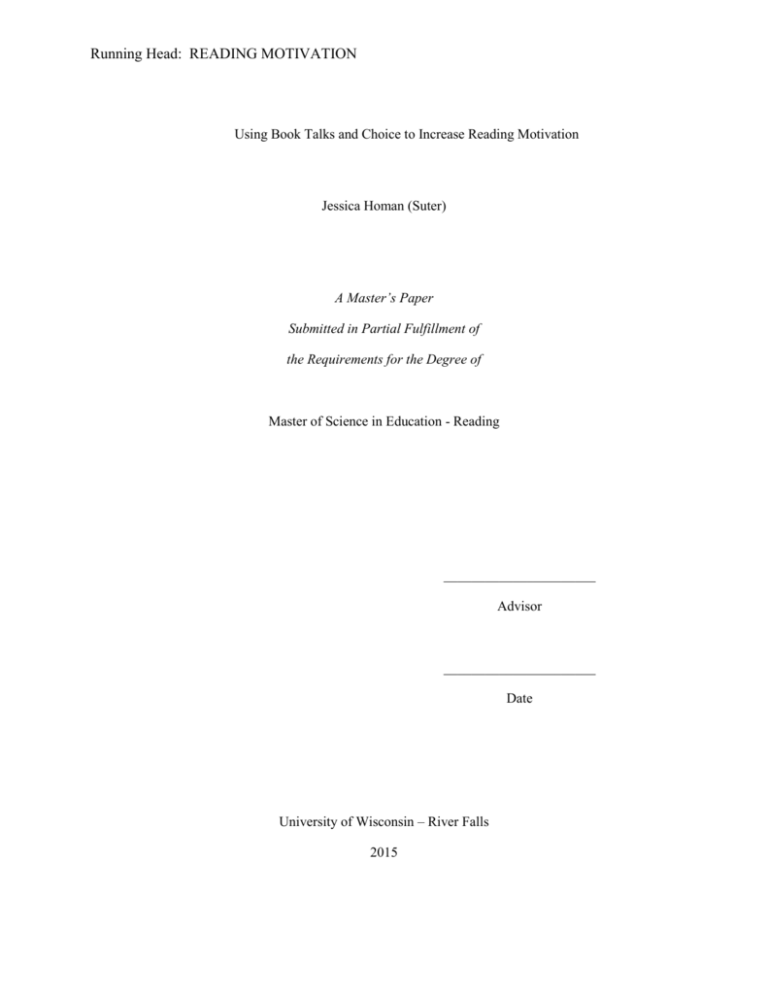
Running Head: READING MOTIVATION Using Book Talks and Choice to Increase Reading Motivation Jessica Homan (Suter) A Master’s Paper Submitted in Partial Fulfillment of the Requirements for the Degree of Master of Science in Education - Reading ______________________ Advisor ______________________ Date University of Wisconsin – River Falls 2015 READING MOTIVATION 2 Using Book Talks and Choice to Increase Reading Motivation Jessica Homan (Suter) University of Wisconsin – River Falls READING MOTIVATION 3 Abstract The purpose of this action research was to show how book talks and student choice can have an impact on students’ motivation to read. A book talk is when a teacher or student tells the class a little bit about the book in order to get them interested to read it on their own. Analysis of the qualitative and quantitative data revealed that eight of the eleven students who participated in this study increased their reading motivation, while the other three remained the same. Furthermore, all of the students enjoyed having one day per week designated for book talks and choice reading and recommended that it continue as a part of the intervention block. In order for students to sustain a lifelong love of reading, they need to be intrinsically motivated to read. This study demonstrated that intrinsic motivation can be developed through book talks and allowing students to select their reading materials. For teachers to motivate students, they must be responsive to the different literacy personalities that each student brings to the classroom. In addition, teachers can contribute to reading engagement when they share their passions and struggles about reading with students. Keywords: reading motivation, engagement, book talks, choice READING MOTIVATION 4 Introduction During the 2013-2014 school year, I noticed minimal excitement in my 2nd second grade classroom during “Read-to-self” time, one of the components of The Daily Five, a strategy I use to organize my reading instruction. It made me sad to observe kids asking, “Is silent reading over yet?” I wanted my students to be so engaged in their books that the time flew and they groaned when I told them it was time to switch to a new activity. This was also concerning to me because researchers have shown that students who enjoy reading the most are more proficient readers (Gambrell, 2011). In addition, they have pointed out that students who are intrinsically motivated to read will have better reading comprehension. I hypothesized that one of the reasons students were getting bored was because they didn’t realize all of the good books that were in our library. Another reason could have been that they were picking books that didn’t excite them or that they didn’t connect with. As I reflected on the cause of these problems, I identified two possible reasons: 1) I had not taught students how to discuss and share books; and 2) I did not do enough book talks to get kids excited about the different kinds of books in our classroom library. These concerns led me to implement a pilot action research study on this topic in my classroom. My action research question was: What effect do teacher and student “book talks” have on student motivation to read? The results of my study showed that the “book talks” I gave helped increase student engagement and also helped increase their excitement about reading. During the 2014-2015 school year my job description changed and I no longer had “readto-self” time. I was working primarily as a Title I reading and math teacher. Title I is a federally funded program that provides interventions for students who are below grade level in reading or READING MOTIVATION math. In our school district Title I teachers work with these students for 30 minutes each day. The group sizes vary from one to four children. In Title I reading, we primarily use a program called Leveled Literacy Intervention (LLI) with our students. LLI is a research based program that provides new books for students daily and has teaching points for teachers to follow. In addition, the students take home a copy of the book daily to practice reading at home. As the year went on and I talked with my students, I noticed that they were rarely rereading these books at home. Furthermore, they admitted that they were not usually reading for enjoyment at all. As I tried to identify why this was happening, I hypothesized that: 1) Students did not want to re-read books we had already read in class; 2) Students had not found or been shown books that truly excited them. This led me to want to continue my action research about book talks and student motivation, but this time I wanted to research how these factors affected their choice reading at home. Some of the related sub-questions that I explored were: What motivates students to read? What does a good book talk include? How does student choice affect motivation to read? How do book talks influence the variety of books that students choose? What are the best books for boys who are reluctant readers? What ways can students share their opinions about books they’ve read with their classmates? How does student collaboration about books affect their motivation to read? The purpose of this study was to increase what Csikszentmihalyi (1991) noted as ‘flow’ in my students’ reading (as cited in Cole, 2002, p.329). This means that I want students to be so 5 READING MOTIVATION 6 involved in their reading that they lose track of time and can only think about the book they’re reading. They are “in the flow.” I think that when students experience flow in reading, they become more motivated to read again; thus their intrinsic motivation for reading will increase. Findings from this study are important to all teachers, especially those who teach reading, because they lend insight into possible strategies for increasing students’ reading motivation and engagement. Review of Related Literature Reading Motivation A student’s motivation to read is arguably one of the most important factors in their reading success. According to Gambrell (2011), “Highly motivated students who see reading as a desirable activity will initiate and sustain their engagement in reading and thus become better readers” (p. 172). Research by Allington (2001) supports this by verifying that students need to spend a lot of time reading in order to improve their skills (as cited in Jones, 2006, p. 576). If students are not engaged, we cannot expect them to become better readers. In addition, children are motivated to read by a variety of factors. Thus, it is important for teachers to recognize how they can increase student’s reading motivation (Metsala, 1996). Metsala (1996) notes the importance of distinguishing between intrinsic and extrinsic motivation. Intrinsic motivation is when students are motivated by something within themselves. Intrinsic motivation typically falls into one of four categories: curiosity, involvement, challenge, and/or social interaction. Extrinsic motivation frequently stems from teachers or parents. Some reasons that students might be extrinsically motivated are for recognition, compliance, or getting good grades. Metsala also found that in order for students to experience lifelong, voluntary reading, they need to be intrinsically motivated. Gambrell’s research supports this conclusion READING MOTIVATION 7 (2011). In her article, Seven Rules of Engagement, she concluded that students are more motivated to read when: 1. the reading tasks and activities are relevant to their lives; 2. they have access to a wide range of reading materials; 3. they have ample opportunities to engage in sustained reading; 4. they have opportunities to make choices about what they read and how they engage in and complete literacy tasks; 5. they have opportunities to socially interact with others about the text they are reading; 6. they have opportunities to be successful with challenging texts; and 7. classroom incentives reflect the value and importance of reading (p 173). Looking deeper into Gambrell’s seven motivators, it is clear that the tasks teachers assign to students are extremely important in influencing a student’s reading motivation. In fact, in a study of how literacy tasks influence children’s motivation for literacy, Turner (1995) found that the daily tasks teachers do with students, not the type of reading program, are the most reliable indicators of student’s motivation. The tasks in Turner’s study were separated into two different categories, open or closed. Open tasks were ones that students had more control over. They provided more choice, challenge and opportunities for collaboration through reading and writing. For example, if students were writing, they decided what interested them, how to organize it to create a theme, and what they wanted the final message to be. Closed tasks were described as ones where the process or product had one correct answer. An example of a closed task is completing a worksheet with cloze sentences in which students had to fill in the blanks with selected vocabulary words. The study showed that open tasks were more likely to develop learners who had intrinsic motivation. READING MOTIVATION 8 Reading motivation is multifaceted and complex. In a study about motivation for reading Cole (2003) identified four case study students; findings showed that nineteen different aspects of motivation were present, and that none of the motivators were common to all four case study students. The case study by Cole relates to the theoretical model of engagement shown below from Guthrie (2004). This model is centered around a box of the desired student outcomes, which are achievement, knowledge, and reading practices. On the outside of the box, the four processes of reading engagement are posted: social interactions, motivations, conceptual knowledge, and strategy use. The outer ring of this figure consists of ovals which represent the characteristics of classrooms that show high levels of reading engagement in students. Guthrie concluded that all of the characteristics in the outer ring are necessary for high reading engagement. Cole (2003) and Guthrie (2004) agree that one of a teacher’s greatest challenges is to meet the needs of all the different literacy personalities in their classroom and motivate them to be lifelong learners. They emphasize that since there are so many diverse personalities, teachers READING MOTIVATION 9 should stay focused on encouraging intrinsic motivation instead of trying to teach all children in the same way. Teacher Book Talks and Student Choice Gambrell (2011) notes the importance of teacher book talks. A book talk is when the teacher shares a small number (10-12) of books with a goal of piquing children’s interest and curiosity about the books, thus motivating them to read the books that are introduced. Gambrell’s second rule of engagement is directly related to this idea. She shares the importance of not only having the books available to children, but also making students aware of all the types of books in the classroom and library so they can find some that truly interest them. Gambrell (2011) also suggests that doing book talks will increase the amount of books that students know about, which gives them a better chance of finding something they are interested in. A book talk may also include a short read-aloud from a few of the selected books. When students hear part of a book they will often be more interested in reading the rest or finding another book by the same author or in the same series (Miller, 2012). Teacher book talks are an effective strategy to model a love and appreciation for reading. Pecjak and Kosir (2008) found that when teachers share their love of reading and become reading models, it enhances their student’s reading motivation. Schunk and Zimmerman (1997) found that teachers who incorporate their purpose for reading, along with their beliefs about its importance, can improve students’ self-efficacies and intrinsic motivation. Book talks are important because they lead to student choice. Donalyn Miller’s (2012) article “Creating a Classroom Where Reader’s Flourish” cited many small things teachers can do to increase the volume that students read. She noted that there wasn’t a single other practice that inspired her students to read as much as the opportunity to choose their own books. She also READING MOTIVATION 10 discovered that when she gave book talks about certain books to her students, selection of these books would spread like wildfire. However, if she assigned the same book as part of class, her students were less likely to want to read it. When she asked students about this, they responded by saying, “When teachers tell us we have to read a book, we hate it.” (Miller, 2012, p.91) Her study revealed that the most important factor for her students was whether they could choose to read the book or not. Another thing that Miller found was the importance of asking students what book they will be reading today instead of telling them what to read. When you give students the power to choose what they’re reading, then it removes the opportunity for them to refuse to read at all. In relation to student choice, a study by Reynolds and Symons (2001) also suggests that self-determination, control over the learning situation, and autonomy are critical aspects of student choice. Student and Teacher Collaboration When students have the opportunity to socially interact with their peers and teachers about the text they are reading, they are more motivated to read. Social interaction within literacy can be looked at as any type of communication with others, such as; writing, discussing, talking, and/or sharing. In terms of reading motivation, peer comments can make students more interested in books. In addition, when a child sees another child’s progress, their own confidence may improve. Finally, when students work together it promotes both interest and engagement (Gambrell, 2011). In a study of literacy tasks in 12 first grade classrooms, Turner (1995) discussed the importance of students being able to select their own books and discuss them with classmates. She stated that as students share their evaluations of books with their peers, they frequently READING MOTIVATION 11 discover new books. All of the new books that students are exposed to build on the positive experiences they have with literacy. Turner notes that it is important for teachers to encourage collaboration. One of the qualities of teachers who foster students’ reading motivation is that they make sure to choose activities in which students have a lot of opportunities to work with a variety of other students. Guthrie (2004) described the importance of teachers making sure students know how to collaborate effectively. He noted that when collaboration between students is successful, students are socially immersed which will increase intrinsic motivation. An important aspect of collaborating is that it gives students the opportunity for selfexpression. Cole (2003) cites Guthrie and McCann’s definition of self expression as “when students relate personal experiences to their responses and allow their own viewpoints to be heard” (p. 329). When students talk about the books they’ve read with their classmates, this provides them the chance to express their thoughts. Student collaboration and expression can also happen through response sheets or opinion graphs (Cole, 2003). Although some students can learn effectively on their own, many children need the support of their peers in order to achieve their highest potential as readers. The collaboration and relationships between teachers and students can also impact student motivation. In Miller’s (2012) study she recognized the importance of celebrating any reading that her students do. She doesn’t judge what types of books they choose, as long as they are reading. By her showing her support for their reading choices, students start to trust themselves in selecting books and in listening to the books she suggests. She really tries to send the message to her students that any reading they do is much better than not reading at all. Amanda Gulla’s (2012) research of a 9th grade literacy class at a Bronx Vocational High School revealed many important factors relating teacher-student relationships and student READING MOTIVATION 12 motivation to read. The teacher Gulla worked with was honest with her students about where they were as readers and what they needed to do to improve. She built trust with the students, and they realized that she had their best interests at heart. She taught the importance of reading stamina and worked to change the students’ perceptions of themselves as readers. The teacher’s classroom was one that acted as a “readers’ club” where students could interact around books with their peers and supportive adults. One of this teacher’s many success stories was of a student coming back to her classroom three years later to acknowledge the impact that her class had on him as a reader and a student. Methodology Introduction After reviewing this related literature, I wanted to study children’s motivation and engagement in reading; specifically what effect teacher and student book talks can have on students’ motivation to read. Research shows that students who are motivated to read often read more and become better readers. One focus of my study is on intrinsic motivation which is said to have the greatest effect on student motivation. Book talks and choice should encourage students to become intrinsically motivated to read more. Furthermore, the relationships that I have with my students and that I encourage with their peers are also factors that contribute to their motivation. This study is based on the premise that when teachers and students participate in book talks they will be more motivated to read because their interest will have been piqued by hearing about the book from a teacher or classmate. Participants and Setting This study was conducted in a small rural community in a northwestern Wisconsin. The participants in this study attend a K-5 elementary school with approximately 140 students. READING MOTIVATION 13 Furthermore, the eleven students that were part of this study are all in the Title I reading program. They qualify for this program if they have test scores that are below benchmark and/or teacher observations and classroom data show that they could benefit from additional small group instruction. In this study, there were four boys in third grade, three boys in fourth grade, and four girls in fifth grade. They were with me in a 1:3 or 1:4 teacher/student ratio for 30 minutes, five days per week. Before we started the study, I was using the Leveled Literacy Intervention (LLI) every day with students. Materials All parent/guardians of students participating in the research signed a letter of consent, which can be found in Appendix A. In addition, the parents filled out a Reading Interest Survey (Appendix B). Each student then filled out a Student Reading Interest Survey (Appendix C). Furthermore, I (the researcher) took daily or weekly anecdotal notes recording important comments and discoveries throughout the process. The students also had to fill out a Weekly Reading Log (Appendix D). Finally, the bulk of additional materials during this study came from the interests and comments the students made about the types of books they want to read. I used my personal library, school library, and public library system to gather the most appropriate and potentially exciting reading materials for students. Procedures This study was conducted over a six week period. The first week I surveyed the parents and students and began gathering books that I felt would meet the interests and achievement levels of the children. The first Monday following the surveys, I did book talks on eight to twelve books per grade level group. I spent about ten minutes briefly talking about the books. I allowed the students to quickly look them over and choose from the ones I talked about or the READING MOTIVATION 14 other ones in my classroom library. After ten minutes, I did a shortened LLI lesson. Throughout the week I engaged in small conversations with the students about how their choice reading was going. If I saw students in the hallway before or after school I would be sure to casually check in with them on their reading. I took notes on student comments. During the following five weeks the students continued to fill out weekly reading logs and engage in conversations with me about reading. On the second week, I adapted my Monday book talk session so it included more read-aloud time from me in order to get the students hooked on the stories. In addition, I allowed the remaining class time on Mondays to be spent quietly reading the books they chose in order to see if they truly were interested in them. At the end of the six weeks, the students were surveyed again (Appendix E) to see if any of their opinions about reading had changed. In addition, they were asked about their opinion of having one day per week designed to book talks and/or free choice reading. Findings/Results Through this research project I found that book talks have a positive effect on students’ motivation to read. After the first week, I saw some increase in student excitement, but it wasn’t quite where I wanted it to be. After the initial ten minute book talk and book choosing time, I realized that if I was truly going to get kids invested in the books then I needed to give them some free choice reading time with the books I showed in order to get them “hooked.” In addition, I wanted to see if reading aloud more of the actual book instead of just the back cover got them more interested in the stories. I noticed that students were much more likely to finish a book if they had already heard part of the story and had time to see if it was a “good fit” for them. READING MOTIVATION 15 My second week of book talks was very successful and it began the true excitement about reading with each of my three groups. I pointed out to the students that if they didn’t read at home that must be because they had not found the right book yet. I told the students stories about how when I love books I want to read them at any chance I get. I also admitted that sometimes I forget about books I’m reading and I don’t finish them. I explained that this usually means that the books are not a good fit for enjoyment reading for me. I believe that by admitting this to students, they realized it was okay to keep searching for “perfect books” for themselves. During this second week, there were some major breakthroughs with my students. One that I was very excited about was my fifth grade student, Erika. She is the daughter of one of the teachers in my school and struggles with being motivated to read on her own. I received a text message from her dad that she wanted to tell me she finished her book. In the images below you can see our text conversation about Erika’s reading and that it had been a long time since she had finished and/or read a book that she really enjoyed. READING MOTIVATION 16 I had another exciting breakthrough during the second week when I went to a parent meeting and the mom of Danny came up to talk to me right when she saw me. She said, "I don't know where you found these new books for Danny, but they actually have him reading at home.” In the third week of my study, I began encouraging and prompting for more student-tostudent book recommendations. My favorite one came from Hailey. When she was talking to her group, she said, “Seriously, this book is better than a TV show. Are you sure you don’t want to try it?” Jessica ended up agreeing to give it a shot and read the book within a week. It was so gratifying to hear their exchanges about all of the drama that happened in the chapter book, since three of the girls had read it. Then, I was also very impressed because without being prompted Kaylee went to the public library and ordered the next book in the series since I didn’t have it in my classroom. I explained to the group that her taking the initiative to find her next book on her own was exactly what a good reader does. I then shared this story with my other Title I reading groups hoping that it would encourage some of them to show the same initiative. During the third week I had a great conversation with the fourth grade classroom teacher. As we were passing in the hallway, he commented that the students from Title I have had so much fun sharing all of the cool facts they are learning from the books they borrowed from my room. When I explained my research study to him, he commented, “Well their engagement in my classroom silent reading time has definitely increased over the past few weeks since they have had these books from your room.” Another thing that I noted from the fourth grade during this week was that one of my students, Chris, came to my room to ask me if he could lend my book to another student in his class who isn’t in Title I. I was completely thrilled about this, as I felt it meant he had read the book and was so excited about it he wanted to talk to his classmate about it. READING MOTIVATION 17 Four weeks into my study, Danny’s mom approached me to ask if I could tutor her sixth grade son in reading this summer. She said that she thinks if I could get Danny to enjoy reading, then maybe there is a possibility that I could also get her older son to enjoy it as well. I believe that this shows that the book talks had a very positive impact on Danny. During the fifth week of my study I surveyed students to get their opinions about the book talks and free choice reading time that had been offered every Monday. All eleven students agreed that I should continue doing them. The third grade boys stated that they liked the book talks because then they knew what books were about before they began reading them. They also liked that I showed them books they had never heard of before. The fourth grade boys liked that I let them borrow my “expensive non-fiction books like Amazing Animal Facts and 101 Animal Babies.” Furthermore, one of the fourth grade boys commented that he enjoyed the book talks and choice reading, but really he wanted more of the free reading time because the LLI books are not his favorite. The fifth grade girls liked that they had time to talk about books that they chose on Mondays, instead of books that their teacher or I assigned. The fourth and fifth grade students both commented that they liked how I would find books for them that fit their interests so they didn’t just have to keep searching and guessing which ones they might like. The other student survey question that changed quite a bit from beginning to end was the average amount of time that the students’ said they spend reading (for fun) each day. While giving the surveys, I had to clarify that this question meant outside of school. As a group, it went from the majority of them reading zero to ten minutes a day to the majority reading ten to twenty minutes each day. This data is displayed on charts below. The numbers on the pie graph represent the number of students who read that amount of time each day. READING MOTIVATION 18 On average, how much time do you spend reading (for fun) each day? 3 1 1 1 0-10 minutes 0 Minutes 0-10 minutes 7 10-20 minutes 3 10-20 minutes 6 20-30 minutes 40-50 minutes 3/9/15 4/17/15 The statistic was the most exciting to me was that every student’s rating of how much they liked reading on a scale of zero to ten either stayed the same or increased. The scores that stayed the same were all at a six or above before the study. Additionally, every students’ rating was now at a five or higher. Conclusions After reading a variety of articles on reading motivation and reflecting on my own classroom practices, I am intrigued by the impact If you had to rate how much you like reading, you would say it’s a: Student 3/9/2015 4/17/2015 Adam 3 8 George 6 6 Danny 5 7 Seth 10 10 Erik 4.5 8 Chris 6 8 Luke 7 7 Jessica 3 5 Kaylee 3 5 Hailey 4 5 Erika 5 7 that teachers’ actions can have on students’ reading motivation. Book talks are a great way for teachers to get students motivated to choose appropriate and exciting books. Furthermore, I believe that as the students got more excited about books and reading, I was motivated to be the READING MOTIVATION 19 best teacher I could be. It was so rewarding getting positive comments about students’ reading from their parents and classroom teachers that I was even more motivated to find the “perfect” books for the students. For teachers, this means that we cannot just depend on one or two strategies to motivate our students, but rather we must be more responsive to the different literacy personalities that each of our students brings to our classrooms. We should constantly be sharing our passion for books with students, as well as the struggles we’ve experienced. In addition, we should give students choice in what they read. Implications for Further Research I have learned a lot about student motivation to read, and I will continue to do book talks one day per week in my Title I intervention groups. As I continue to work on getting all students motivated to read independently, I will focus more on where the books can be found and how I selected the books I shared with them. If I want my students to truly become lifelong readers, they need to not only read books that their teachers find for them, but they also need to use their own skills and the school and public library systems to find the books. One strategy I am considering to reinforce the importance of self-selection is to actually teach my Monday “book talk and choice reading” classes in the school or public library. Another issue I would like to explore is how I can keep students reading over the summer. Children often lose reading skills over the summer, and a focus on self-selected summer reading could help them to retain the skills and attitudes that are developed during the school year. I think if I could help them to be more comfortable with the public library system and build confidence in their ability to find themselves good books, then maybe they would read more. READING MOTIVATION 20 References Allington, R.L. (2001). What really matters for struggling readers: Designing research-based programs. New York: Addison Wesley Longman. Allyn, P. (2011). Best books for boys: How to engage boys in reading in ways that will change their lives. New York, NY: Scholastic. Cole, J. E. (2002). What motivates students to read? Four literacy personalities. The Reading Teacher, 56(4), 326-336. Csikszentmihalyi, M. (1991). Literacy and intrinsic motivation. In S.R. Graubard (Ed.), Literacy: An overview by fourteen experts (pp.115-140). New York: Hill & Wang. De Naeghel, J., & Van Keer, H. (2013). The relation of student and class‐level characteristics to primary school students' autonomous reading motivation: A multi‐level approach. Journal of Research in Reading, 36(4), 351-370. Gambrell, L. B. (2011). Seven rules of engagement: What's most important to know about motivation to read. The Reading Teacher, 65(3), 172-178. Gulla, A. N. (2012). Putting the “shop” in reading workshop. Building reading stamina in a ninth-grade literacy class in a Bronx vocational high school. National Council of Teachers of English, 101(5), 57-62. Guthrie, J. (2006). Influences of stimulating tasks on reading motivation and comprehension. Journal of Educational Research, 99(4), 232-245. Guthrie, J. T. (2004). Classroom contexts for engaged reading. Motivating reading comprehension. Concept-Oriented Reading Instruction, 1-24. Guthrie, J. T., & McCann, A.D. (1997). Characteristics of classrooms that promote motivations and strategies for learning. In J.T. Guthrie & A. Wigfield (Eds.), Reading engagement: Motivating readers through integrated instruction (pp.128-148). Newark, DE: International Reading Association. Jones, J. A. (2006). Student‐involved classroom libraries. The Reading Teacher, 59(6), 576-580. Metsala, J. L. (1996). How children's motivations relate to literacy. Reading Teacher, 49(8), 660. Miller, D. (2012). Creating a classroom where readers flourish. The Reading Teacher, 66(2), 8892. Pecjak, S., & Kosir, K. (2008). Reading motivation and reading efficiency in third and seventh grade pupils in relation to teachers’ activities in the classroom. Studia Psychologica, 50(2), 147-168. READING MOTIVATION 21 Reynolds, P. L. & Symons, S. (2001). Motivational variables and children’s text search. Journal of Educational Psychology, 93(1), 14-23. Schunk, D. H., & Zimmerman, B. J. (1997). Social origins of self-regulatory competence. Educational psychologist, 32(4), 195-208. Tuner, J. G. (1995). How literacy tasks influence children's motivation for literacy. Reading Teacher, 48(8), 662-673. Wigfield, A., & Guthrie, J.T. (1997). Relations of children’s motivation for reading to the amount and breadth of their reading. Journal of Educational Psychology, 89, 420-432. READING MOTIVATION 22 Appendix A Letter of Consent March 6th, 2015 Dear Parent/Guardian(s), As an educator, I am constantly evaluating the way I do things to figure out if there is a better way they could be done. One of my big interests is in students’ motivation to read. As part of the Reading Master’s program in which I am currently enrolled at UW-River Falls, I have chosen to do an action research study on reading motivation. The goal of this study is to help me collect evidence in teaching techniques that will increase motivation. This project will focus on the effect that book talks can have on a child’s reading motivation. A book talk is when someone tells you enough about a book to get you excited about it, but doesn’t give away the whole story. I am interviewing all of the parents and students I work with on their thoughts and feelings about reading. In addition, I will have students keep a log of their independent reading. Then, I will be presenting my findings to other teachers in an educational setting and it will be included in my final thesis paper. Furthermore, I would be happy to share it with you, if you are interested. I will only use logs and interview questions in the presentation if I have your permission. I will use pseudonyms to protect all children’s privacy. Keep in mind that this is voluntary and if you choose not to grant permission, it will in no way affect your child’s relationship with me or their standing in class. If you have any questions or concerns, please feel free to call or email me. Sincerely, Jessica Homan (Suter) Title I Teacher/Coordinator 2nd & 3rd Grade SAGE Teacher suterj@elmwood.k12.wi.us 715-239-2711 ______________________________________________________________________ I give Jessica Homan permission to use my child’s reading log and survey/interview answers in her action research project for UWRF. I do not give Jessica Homan permission to use my child’s reading log and survey/interview answers in her action research project for UWRF. Child’s Name: _______________________________________ Parent’s Name: ______________________________________ Parent’s Signature: ___________________________________ Date __________ READING MOTIVATION 23 Appendix B Parent Reading Interest Survey Name: _________________________ Date: ___________ Reading Interest Survey I’d like to learn more about your child’s interest in reading so I can make appropriate book recommendations to them. Thank you for your help! ~Mrs. Homan 1. 0 If you had to rate how much your child likes reading, you would say it is a: 1 2 3 4 5 6 7 8 9 (Doesn’t like it) 10 (LOVES IT!) 2. On average, how much time does your child spend reading at home each day? 0 minutes 0-10 minutes 40-50 minutes 50-60 minutes 3. 10-20 minutes 20-30 minutes 30-40 minutes 60+ minutes When I am thinking of books to recommend to your child, what should I keep in mind? (You can share anything you’d like below or use this list to help give you some ideas.) -Genre: adventure, mystery, biography, fantasy, informational, sports, humorous, realistic fiction -Type: picture books, chapter books, series, graphic novels, comics, magazines -Child’s interests/hobbies -Books they’ve liked in the past READING MOTIVATION 24 Appendix C Student Reading Interest Survey Name: _________________________ Date: ___________ Student Reading Interest Survey 1. What kinds of books do you like to read? Circle all that apply Adventure Mystery Biography Historical Science Informational Sports Humorous Realistic Fiction Other __________________ 2. What do you read most of the time? Books Magazines Graphic Novels Text books Comic Books Websites Fantasy Newspapers 3. Where do you find/get most of your “choice” or “fun” reading materials? Public Library School Library Classroom Library LLI Books Mrs. Homan’s Library Home Library 4. Who do you get book recommendations from? Librarian(s) Classroom Teacher Mrs. Homan Friends Family 5. Who do you recommend good books to? 6. On average, how much time do you spend reading (for fun) each day? 0 minutes 0-10 minutes 10-20 minutes 40-50 minutes 50-60 minutes 20-30 minutes 30-40 minutes 60+ minutes 7. If I’m looking for good books for you to read, what should I keep in mind? (picture books, chapter books, series….) What would you be interested in reading right now? 8. If you had to rate how much you like reading, you would say it is a: 0 1 (Don’t like it) 2 3 4 5 6 7 8 9 10 (LOVE IT!) READING MOTIVATION 25 Appendix D Weekly Reading Log Week of ________ Book(s) Read Minutes Child read alone Child read to someone Parent read to child Mark all that apply Monday Tuesday Wednesday Thursday Friday Saturday Sunday Comments: Parent and child read together READING MOTIVATION 26 Appendix E Final Student Survey Student Survey 1. Where do you find/get most of your “choice” or “fun” reading materials? Public Library School Library Classroom Library LLI Books Mrs. Homan’s Library Home Library 2. Who do you get book recommendations from? Librarian(s) Classroom Teacher Mrs. Homan Friends Family 3. Who do you recommend good books to? 4. On average, how much time do you spend reading (for fun) each day? 0 minutes 0-10 minutes 10-20 minutes 40-50 minutes 50-60 minutes 20-30 minutes 30-40 minutes 60+ minutes 5. In the future, should Mrs. Homan continue to do book talks and allow for choice reading one day per week? Why or why not? 6. If you had to rate how much you like reading, you would say it is a: 0 1 (Don’t like it) 2 3 4 5 6 7 8 9 10 (LOVE IT!)
